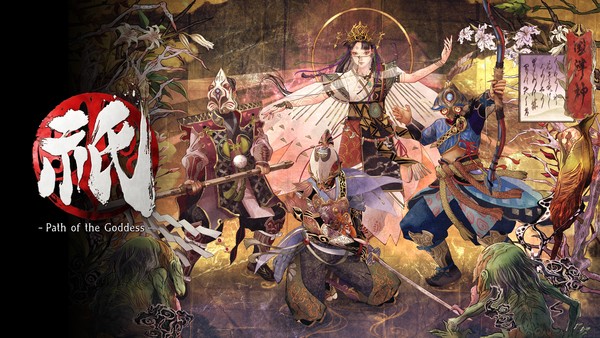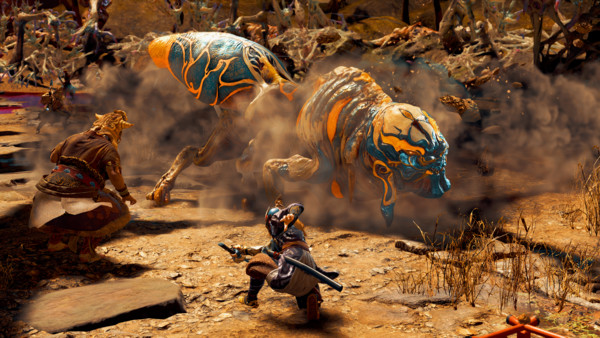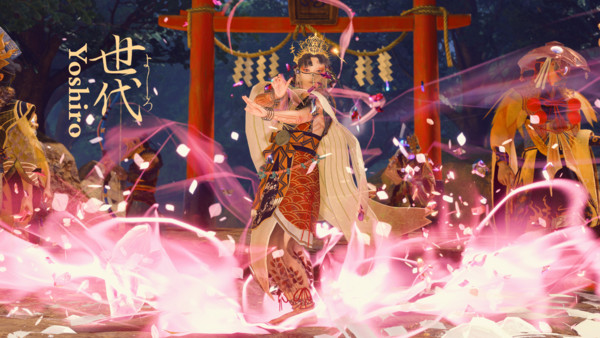Director Kawata and Producer Hirabayashi of Kunitsu-Gami: Path of the Goddess
by Kalai Chik,CAPCOM's upcoming tower defense game, Kunitsu-Gami: Path of the Goddess, caught my eye during Summer Game Fest's presentations for its visuals and folklore motifs. The single-player action game combines stellar strategic gameplay, a detailed environment, clothing design, and an impressive interface. I'm personally fascinated by the architecture of Japanese Shinto and Buddhist shrines, as well as their ceremonies. Like a moth to a flame, I spent an entire afternoon going through the three stages available at CAPCOM's tent.

The story follows Soh, a guardian who guides and leads Yoshiro, a maiden who purifies impurities found on Mt. Kafuku. He leads rescued villagers to hold back the Seethe during Yoshiro's ceremony to purify the defilement that plagues the land. The real-time battle system allows for instant decision-making and changes, allowing for strategies to respond to the transformations in the landscape. Soh slashes and sword dances through the various Seethe, while the villagers rebuild damaged areas and provide backup against the monsters. Through resource management and tactical placement, players can test their strategic abilities while immersing in a world seeped in deep Japanese folklore.
Director Kawata's attention to detail overflows in Kunitsu-Gami. From the menu design to the character's clothes, the game's aesthetics is a feast for the eyes. Unfortunately, the UI design is adjusted for the English version of the game to accommodate for space. Still, an easy switch to the Japanese version allows the player to see Kawata's original vision. Even if you can't read Japanese, I recommend switching over simply to explore how the designs come together.
After my playtest, I spoke with director Shuichi Kawata and producer Yoshiaki Hirabayashi on how they came to develop Kunitsu-Gami.
How long after your Last Game, Shinsekai, did you start working on Kunitsu-Gami?
Shuichi KAWATA: Development for Kunitsu-Gami: Path of the Goddess began right after Shinsekai: Into the Depths launched.
Why are the Seethe called "ikoku" in Japanese?
KAWATA: We wanted to use kanji characteristics that represented how they're a fear against something that you can't see. We wanted to combine that with the "koku" part, the screaming or screeching somewhere far off in the distance. Adding that to the darkness's elements—and its nuance—creates ikoku.
Could you also talk about the types of Seethes?
KAWATA: For the bigger bosses, like this festering Seethe, those are based on Japanese mythologies. Those were the motifs that we were basing it all on. We visualized them in a way that would best fit the game's aesthetics. As for the normal Seethes that would come in waves at night, those are based on Japanese images of yokai. Taking that as a motif, I took a personal take on them and refined them to match the game's aesthetic.

In Shinsekai, humans migrated underwater because of icy conditions created by war. In Kunitsu-Gami: Path of the Goddess, nature has been defiled and corrupted to the point that it requires purification. Why do you include elements of environmentalism in your games?
KAWATA: I believe the interaction between humans and nature is something that can't be separated from each other. They always have to be interlaced. Because of that, I incorporated an environment where we can see how they interact with each other, which is why that is the central theme.
Players worldwide have different ways of playing defense tactic games. What have you learned from the way players have tested Kunitsu-Gami at Summer Games Fest?
KAWATA: I thought the players were fast learners when I watched media and influencers playing on the show floor. They adapted to the gameplay even if they've never played before. It takes time for people to become familiar with the system, but most people were able to get used to it very quickly. Maybe because the overseas players here are more familiar with the genre. Initially, I thought the system might be difficult for them to understand, but that's not the case.
After playtesting the game firsthand in both Japanese and English, I would say the interface design is intuitive for the player to use. How long did it take to develop the design of the UI?
KAWATA: When we developed the UI, we took great care to make it easy to understand. That's why we didn't want to overuse text, so we relied on visuals to indicate what you need to do. I discussed that point thoroughly with the UI designers. We also focused on creating a Japanese aesthetic for the menu when you see it pop up. Not only that, but we also wanted it to be intriguing enough to catch the user's attention, so that they would read and allow for a deeper understanding of what they needed to do.

Let's talk about the changes from day to night. How did you decide on what colors to use for the environment during the different parts of the day? For example, the night focuses on more cyan/orange colors to allow the red colors to pop out. During the day, more greens and purples are highlighted in a sepia-toned backdrop.
KAWATA: During the day, the focus is on the Japanese scenery of the old era to show how the mountain and greenery were expressed in a peaceful way. To contrast that, we used night to express the fearful elements and make it seem like you're setting foot into a world that you may not have seen before. We created it to highlight the otherworldly aesthetics and to create that color contrast between the day and night.
The trailer released in March said, "Coming 2024," while the trailer with an official release date only came out on Friday during the Summer Game Fest presentation. Why did CAPCOM decide to show the date so close to its release?
Yoshiaki Hirabayashi It's difficult to say or give a concrete reason why. When developing this game, we always focus on being able to deliver the game as early as possible and as fast as possible. We wanted them to be excited after announcing the launch day and allow them to get it soon so they wouldn't have to wait long.

What should players look forward to in the game?
KAWATA: Since this game has a unique blend of strategy and action, we want people to experience the outstanding balance we found in mixing those two genres. We want players to feel different than what they initially thought the game would be but in a good way. The more you play it, the more you become familiar with tactics, strategies, and comments, making it more interesting to play.
HIRABAYASHI: Regarding the story, it focuses on the maiden, Yoshiro, who can purify the defilement, and the guardian, Soh, who is a character that the player controls. The two of them progress through the story to purify the defilement from Mt. Kafuku. The story is straightforward, but when you play it, many elements are portrayed in the story that depict a deep lore. We hope that the players will be able to find out the story behind these two characters while playing it. We'd like to see how players interpret and feel when reaching the end.